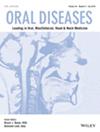OSR1 suppresses oral squamous cell carcinoma proliferation and migration via the AXIN2/β‐catenin pathway
IF 2.9
3区 医学
Q1 DENTISTRY, ORAL SURGERY & MEDICINE
引用次数: 0
Abstract
ObjectivesThe odd‐skipped related transcription factor 1 (OSR1) gene exerts distinct regulatory effects on tumorigenesis and development in various cancer types. However, the precise role of OSR1 in oral squamous cell carcinoma (OSCC) remains to be elucidated.MethodsGEPIA 2 and TCGA databases were utilized to analyze the OSR1 expression in head and neck squamous cell carcinoma (HNSC) patients and its impact on prognosis. Hematoxylin–eosin staining, immunohistochemistry, immunofluorescence, western blotting, and RT‐qPCR were employed to detect the OSR1 expression in OSCC tissues and cells. Lentivirus transfection was utilized for overexpression and downexpression of OSR1 in OSCC. CCK8 cell proliferation assay, colony formation and cell scratch assay were conducted to investigate the effects of OSR1 on biological behavior of OSCC cells. Western blotting and RT‐qPCR were applied to investigate the regulatory mechanism of OSR1 on AXIN2/β‐catenin signaling pathway.ResultsOSR1 expression was significantly decreased in HNSC patients, OSCC tissues and cells, leading to a decrease in 5‐year survival rate. OSR1 overexpression inhibited the proliferation and migration of OSCC cells, and the AXIN2/β‐catenin signaling pathway was inhibited. Silencing OSR1 had the opposite effect.ConclusionsOSR1 functioned as a tumor suppressor gene in OSCC proliferation and migration by regulating the AXIN2/β‐catenin signaling pathway.OSR1 通过 AXIN2/β-catenin 通路抑制口腔鳞状细胞癌的增殖和迁移
目的奇数跳转相关转录因子1(OSR1)基因对各种癌症类型的肿瘤发生和发展具有不同的调控作用。方法利用GEPIA 2和TCGA数据库分析OSR1在头颈部鳞状细胞癌(HNSC)患者中的表达及其对预后的影响。实验采用血红素-伊红染色、免疫组化、免疫荧光、Western印迹和RT-qPCR等方法检测OSR1在OSCC组织和细胞中的表达。慢病毒转染用于OSR1在OSCC中的过表达和降表达。采用 CCK8 细胞增殖试验、集落形成试验和细胞划痕试验研究 OSR1 对 OSCC 细胞生物学行为的影响。结果OSR1在HNSC患者、OSCC组织和细胞中的表达显著下降,导致5年生存率下降。OSR1的过表达抑制了OSCC细胞的增殖和迁移,并抑制了AXIN2/β-catenin信号通路。结论OSR1通过调节AXIN2/β-catenin信号通路,在OSCC增殖和迁移过程中发挥抑癌基因的作用。
本文章由计算机程序翻译,如有差异,请以英文原文为准。
求助全文
约1分钟内获得全文
求助全文
来源期刊

Oral diseases
医学-牙科与口腔外科
CiteScore
7.60
自引率
5.30%
发文量
325
审稿时长
4-8 weeks
期刊介绍:
Oral Diseases is a multidisciplinary and international journal with a focus on head and neck disorders, edited by leaders in the field, Professor Giovanni Lodi (Editor-in-Chief, Milan, Italy), Professor Stefano Petti (Deputy Editor, Rome, Italy) and Associate Professor Gulshan Sunavala-Dossabhoy (Deputy Editor, Shreveport, LA, USA). The journal is pre-eminent in oral medicine. Oral Diseases specifically strives to link often-isolated areas of dentistry and medicine through broad-based scholarship that includes well-designed and controlled clinical research, analytical epidemiology, and the translation of basic science in pre-clinical studies. The journal typically publishes articles relevant to many related medical specialties including especially dermatology, gastroenterology, hematology, immunology, infectious diseases, neuropsychiatry, oncology and otolaryngology. The essential requirement is that all submitted research is hypothesis-driven, with significant positive and negative results both welcomed. Equal publication emphasis is placed on etiology, pathogenesis, diagnosis, prevention and treatment.
 求助内容:
求助内容: 应助结果提醒方式:
应助结果提醒方式:


